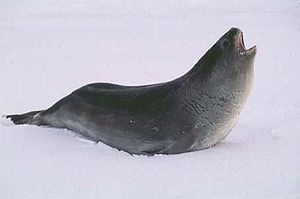Ross Seal
| Ross Seal | ||||||||||||
|---|---|---|---|---|---|---|---|---|---|---|---|---|

Ross Seal |
||||||||||||
| Systematics | ||||||||||||
|
||||||||||||
| Scientific name of the genus | ||||||||||||
| Ommatophoca | ||||||||||||
| JE Gray , 1844 | ||||||||||||
| Scientific name of the species | ||||||||||||
| Ommatophoca rossii | ||||||||||||
| JE Gray, 1844 |
The Ross Seal ( Ommatophoca rossii ) is a in south polar waters spread Robbe . It is named after the British explorer and navigator James Clark Ross , during whose Antarctic expedition (1839–1843) it was first sighted and described.
features
Ross seals are significantly smaller than other Antarctic seals. They become about 2 m long and weigh up to 200 kg. The color is dark brown on top and silvery white on the underside. Towards the Antarctic winter, the fur gradually fades and turns light brown. Seen up close, this seal can be easily identified by its huge eyes (each 7 cm in diameter).
habitat
While Weddell seals , crab-eaters and leopard seals are ubiquitous in the Antarctic seas, the horse seal is a rare animal that has not been well researched. It lives around the Antarctic (and not just in the Ross Sea, as the name might suggest). It almost never leaves the Antarctic waters, stray individual animals on the coasts of sub-Antarctic islands and (in one case) on the coast of South Australia are very rare.
Way of life
The horse seal is a solitary seal that dives for cephalopods and fish . It specializes more than other seals in squids, which make up around two thirds of their prey. Like other Antarctic seals, the horse seal is hunted by killer whales and leopard seals .
The horse seal has a vocal machine that enables it to make chirping sounds that carry far underwater. The purpose of these sounds is unknown; they may play a role in maintaining underwater territories.
In November the females give birth to their young on the ice. It is only suckled for four weeks and then left alone. Horse seals become sexually mature at three years of age, and life expectancy is probably just over 20 years. Shortly after leaving her cub, the female mates with a male underwater.
Duration
The horse seal was not discovered until the 1840s. In the next 100 years it was sighted no more than fifty times. Even so, it is not as rare as these data might suggest. A stock of at least 130,000 is assumed, over 200,000 are believed possible. The inaccessibility of the habitat is the reason that relatively little is still known about the horse seal.
literature
- Judith E. King : Some aspects of the anatomy of the Ross seal, Ommatophoca rossi (Pinnipedia: Phocidae). British Antarctic Survey Scientific Reports 63, 1969, pp. 1-54
- Ronald M. Nowak: Walker's Mammals of the World . 6th ed. Johns Hopkins University Press, Baltimore, Md. 1999 ISBN 0-8018-5789-9 (2 vols.).
Web links
- Ommatophoca rossii inthe IUCN Red List of Threatened Species 2013.1. Listed by: Southwell, C. (IUCN SSC Pinniped Specialist Group), 2008. Retrieved October 13, 2013.
Individual evidence
- ↑ Ross Seal. In: Lexicon of Biology (online version). Retrieved May 2, 2020.
